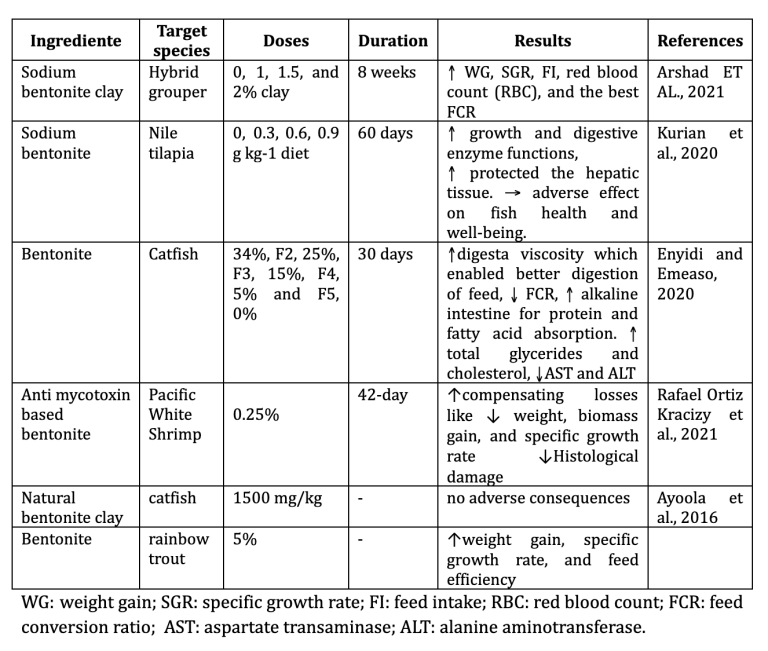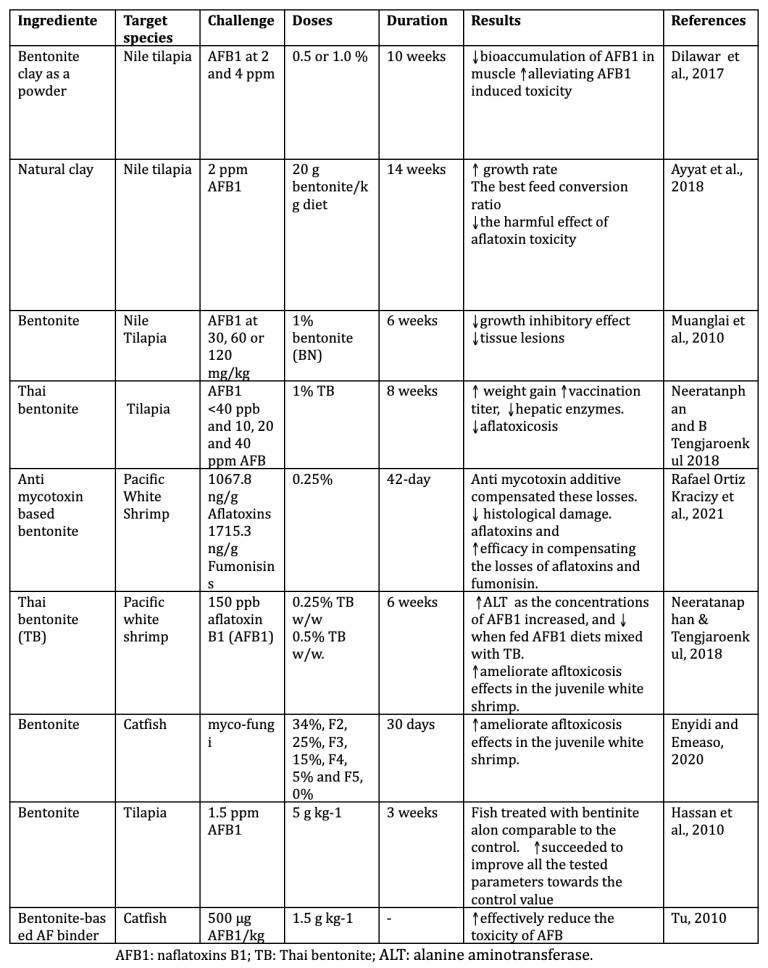Clay minerals, such as aluminosilicates like zeolites and bentonites, are widely acknowledged for their diverse applications across industries (Tang et al., 2014). In aquaculture, their efficacy depends on factors like size, chemistry, shape, surface area, and physical characteristics (Al-anber, 2010), covering traits such as viscosity, color, plasticity, and absorption capacity.
Various aluminosilicate clays, including bentonites, sepiolite, and zeolites, show significant efficacy in aquaculture applications (Zamparas et al., 2012). Their performance in mitigating nitrogen compounds in aquatic environments is influenced by pH, temperature, cation exchange capacity (CEC), and the presence of ions (Jović-jovičić et al., 2010).
Addressing heavy metal pollution concerns, aluminosilicate clays offer an economically viable alternative for heavy metal removal, providing a cost-effective solution compared to activated carbon (Padilla-Ortega et al., 2013).
In animal nutrition, incorporating clay minerals into feed (1-5%) enhances pellet durability (Asgharimoghadam et al., 2012). Bentonite, an approved anti-caking agent, effectively serves this purpose. Additionally, clay minerals act as gut protectants by efficiently binding aflatoxins within animal diets, reducing absorption while maintaining mineral metabolism (Carraro et al., 2014). In cost-effective and readily available solutions for aquaculture feed production, clay minerals stand out as preferred adsorbents.
Mineral adsorbents for mycotoxins
Inorganic adsorbents cover a wide range of materials, among which the mineral family of aluminosilicates stands out for its mycotoxin-binding capacity. Aluminosilicates share the main characteristic of forming tetrahedral units of silicon and oxygen to constitute different crystalline structures. Within the group, there are two subclasses of crystalline minerals: phyllosilicates, such as smectites, and tectosilicates, including zeolites (Di Gregorio et al., 2014). However, these crystalline materials are generally found in natural clays at different levels of purity, coexisting with other types of minerals (EFSA, 2009). In this context, natural clays and their derivates with mycotoxin-binding properties have attracted increasing attention due to their high efficacy, great chemical stability, and advantages of compatibility with other ingredients, as well as their significant natural abundance, low environmental impact and non-toxicity (Li et al., 2018).
Impact of Bentonite and Sepiolite Clay Minerals in Aquafeeds
1. Physical Characteristics of Aquafeeds
Incorporating natural bentonite and sepiolite into aquafeeds significantly enhances feed attributes, yielding multifaceted benefits in aquaculture. Bentonite, approved for both food and feed use, acts as a binder, elevating pellet durability within aquafeeds. This augmented pellet resilience offers several advantages:
- Enhanced pellet durability contributes to improved feed utilization.
- Robust pellets enable more efficient fish consumption, fostering heightened nutrient intake, accelerated growth, and overall enhanced fish health and production efficiency.
- Utilization of bentonite and sepiolite as binders plays a crucial role in preserving water quality, diminishing disintegration in water, minimizing feed wastage, and reducing the accumulation of uneaten feed in aquatic environments.
- The cohesive nature of excrement, facilitated by bentonite, aids in its collection for digestibility assessments, providing valuable insights into nutritional efficiency and fish health.
2. Impact on fish Performance, Feed Utilization, and productive parameters
Bentonite enhances productive parameters by positively influencing physiological factors (blood), palatability, and digestibility. Recognized for its distinctive properties, bentonite acts as a binder for various substances, encompassing pathogens, enzymes, and toxins (Murray, 2000). Positive outcomes were noted when incorporating elevated levels of natural bentonite at 5 and 10% into diets at modest inclusion rates (Eya et al., 2008). Likewise, Ayoola’s 2016 study on catfish revealed that even a relatively small quantity of bentonite, such as 0.05 mg/kg feed, positively influenced fish growth and efficiency.
Arshad et al. (2021) demonstrated increased weight gain, specific growth rate, feed intake, red blood count, and an improved feed conversion ratio in Hybrid Grouper. In parallel, Kurian et al. (2020) reported enhanced growth and digestive enzyme functions with protected hepatic tissue in Nile Tilapia. Concurrently, Enyidi and Emeaso (2020) observed improved digesta viscosity, reduced feed conversion ratio, enhanced alkaline intestine, and favorable changes in biochemical parameters in Catfish. Moreover, Rafael Ortiz Kracizy et al. (2021) found that anti-mycotoxin-based bentonite effectively compensated for the negative effects of aflatoxins and fumonisins in Pacific White Shrimp. likewise, Ayoola et al. (2016) identified an optimal inclusion level of 1500 mg/kg of Natural Bentonite Clay in Catfish, showcasing positive effects on growth and body composition without adverse consequences. Additionally, studies by Eya et al. (2008) demonstrated that including 5% bentonite in the diet resulted in optimal outcomes for weight gain, specific growth rate, and feed efficiency in rainbow trout.
The table 1 summarizes some studies on the use of different forms of bentonite in various aquaculture settings, targeting species such as hybrid grouper, Nile tilapia, catfish, and Pacific White Shrimp.
Table 1. Effect of Bentonite on Growth and Health Parameters in Different Aquatic Species.

3. Impact on Gut Transit Rate
Understanding how bentonite clay inclusion in fish diets influences gut transit rate is crucial for comprehending its impact on digestive processes and nutrient utilization.
Ayoola et al. (2016) reported a reduced rate of stomach emptying in diets containing clay minerals compared to the control diet. This deceleration is ascribed to the binding properties of bentonite clay, leading to an increase in viscosity, a phenomenon corroborated by other investigations (Leenhouwers et al., 2007; Sinha et al., 2011). The delay in feed passage induced by increased viscosity contributes to an extended retention of feed particles, particularly in the stomach and intestines, where subsequent breakdown and nutrient absorption take place.
The extended retention of feed particles within the gut, facilitated by bentonite inclusion, allows for prolonged exposure to digestive enzymes and processes, leading to more thorough nutrient digestion. With an extended digestion period, the absorption of essential nutrients becomes more efficient, ultimately enhancing nutrient utilization by fish (Yener et al., 2012; Ayoola et al., 2015).
Bentonite’s impact on gut transit rate extends the retention of feed particles within the digestive tract, ensuring thorough nutrient digestion and promoting effective nutrient absorption. Therefore, incorporating bentonite as a dietary additive can enhance overall feed utilization and contribute to the growth and health of fish in aquaculture systems.
4. Water Quality in Aquaculture
The use of bentonite in aquaculture has profound implications for enhancing water quality in aquatic systems. Bentonite, a specific type of smectite clay mineral, possesses properties that make it effective in influencing water quality. Key among these is its capacity to absorb water, leading to swelling and moisture retention. Additionally, bentonite exhibits pronounced adsorption properties, attracting and binding various substances, including ammonia and other cations such as metallic ions, heavy metals, and organic pollutants.(Slamova et al., 2011; Taylor, Bellir, Lehocine & Meniai, 2013).
A critical concern in aquaculture is the presence of ammonia, a common waste product from fish metabolism and the decomposition of organic matter. Elevated ammonia levels can be detrimental to aquatic organisms (Romano & Zeng, 2013), leading to high mortality rates and reduced growth in aquaculture. Bentonite’s ability to adsorb ammonia and other cations significantly reduces ammonia levels in water through ion exchange and adsorption mechanisms. When water flows through areas rich in bentonite or when bentonite is introduced into the aquatic environment, it binds with ammonia ions, effectively removing them from the water.
The extensive surface area of bentonite enhances its adsorption capabilities by providing ample contact points for interactions with water and dissolved substances. Additionally, the cation exchange capacity (CEC) of bentonite facilitates the exchange of ions between clay particles and the surrounding water, resulting in the removal of undesirable substances. By diminishing ammonia levels and fostering improved water quality, the incorporation of bentonite into aquaculture practices contributes to creating a healthier environment for aquatic organisms. Enhanced water quality positively impacts fish and other organisms, leading to improved growth, enhanced immune responses, and overall productivity (Ayoola et al., 2016).
Further research by Fagbenro & Jauncey (1995) and Gatlin et al. (2007) emphasized the positive effects of bentonite incorporation in aquafeeds, highlighting improved physical characteristics leading to superior feed utilization, reduced wastage, and enhanced water quality.
5. Mitigation of Mycotoxins in Aquaculture
Mitigating mycotoxins, especially aflatoxin B1 (AFB1), poses a significant challenge in aquaculture. Bentonite emerges as a crucial player in addressing this challenge, offering a potential solution to alleviate the harmful consequences of mycotoxin contamination in aquatic environments. Mycotoxin-contaminated feed can lead to adverse health effects in aquatic organisms, including reduced growth, compromised immune responses, and organ damage. Controlling mycotoxin contamination is vital for ensuring the well-being and productivity of aquatic species.
The use of binders to adsorb toxic molecules in aflatoxin-contaminated feed has gained attention. These adsorbents are integrated into the diet to prevent the absorption and metabolism of toxins (Phillips, Lemke, & Grant, 2002). Meanwhile, Hussain et al. (2017) assessed the effectiveness of 4TX bentonite clay at different inclusion levels in mitigating AFB1-induced toxicity in Nile tilapia, observing improved growth performance in supplemented fish groups compared to the control. The form of clay inclusion, either as a powdered mix (PM) or water dispersal (WD), influenced outcomes, with the PM form showing superior results.
Furthermore, Zychowski et al. (2013) reported a protective effect of bentonite clay against AFB1-induced toxicity in Nile tilapia. Also, Hassan et al. (2010) concluded that Egyptian bentonite (EB) and montmorillonite (EM) effectively reduce the bioavailability of AFB1 in the gastrointestinal tract of fish. Montmorillonite can adsorb high aflatoxin concentrations from aqueous solutions. Addtionally, Kannewischer (2006) noted smectite clay’s decades-long use in animal studies to adsorb and mitigate AFB1’s toxic effects. In a similar study, Jaynes & Zartman (2011) found that adding clays like bentonites decreased aflatoxin toxicity in animal feeding trials. Their results showed that montmorillonite, when treated with choline and creatinine, adsorbed and reduced more AFB1 from aqueous corn flour solutions compared to untreated groups.
Meanwhile, In a study involving tilapia feed, a combination of montmorillonite and bentonite clay adsorbents at 5 g kg-1 feed demonstrated the ability to improve various performance indices in tilapia fish exposed to a diet with 1.5 ppm AFB1 (Hassan et al., 2010). Expanding the scope, Tu (2010) found that a bentonite-based AFB binder at 1.5 g kg-1 feed effectively reduced AFB1 toxicity in catfish fed a diet containing 500 μg AFB1/kg compared to a treatment with 50 μg AFB1/kg only. Furthermore, Muanglai et al. (2010) reported complete mitigation of AFB1 toxicity in Nile tilapia fish by supplementing bentonite in the diet. Addtionally, Selim et al. (2014) demonstrated the effectiveness of three different adsorbent binders in reducing the adverse effects of AFB1 in Nile tilapia. In Pacific White Shrimp exposed to 1067.8 ng/g Aflatoxins and 1715.3 ng/g Fumonisins, the incorporation of an anti-mycotoxin-based bentonite at a concentration of 0.25% demonstrated an increased efficacy in compensating for the losses induced by aflatoxins and fumonisin, as evidenced by a significant reduction in histological damage table 2.
Table 2. Effects of bentonite in aquatic species challenged with mycotoxins.

In conclusion, clay minerals, specifically bentonite, have a substantial impact on aquafeeds and fish. Their ability to improve feed durability, enhance fish performance, modulate gut transit rates, contribute to water quality improvement, and mitigate mycotoxin contamination makes them valuable additives in the aquaculture industry. These versatile clay minerals offer practical solutions to challenges faced in fish farming, ultimately benefiting both fish health and production efficiency in aquaculture systems.



